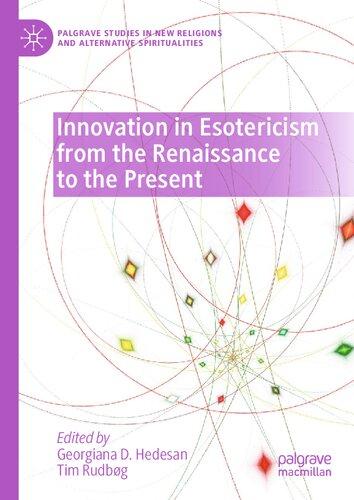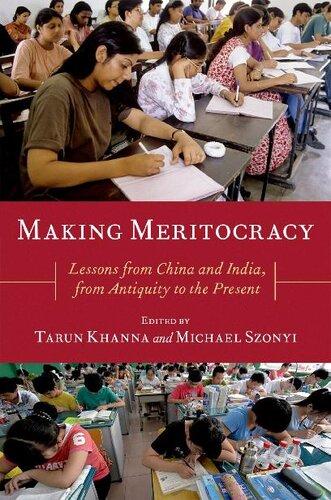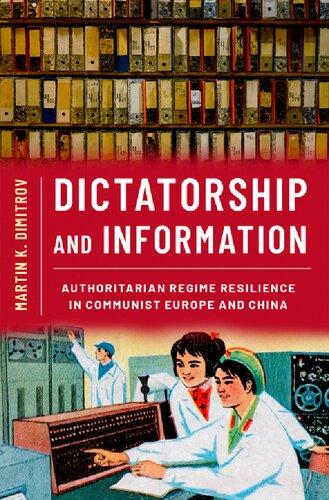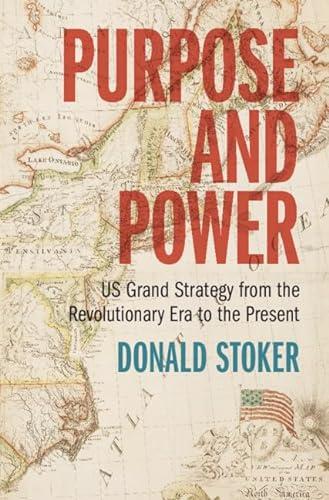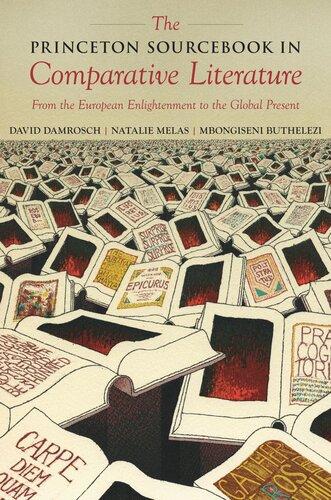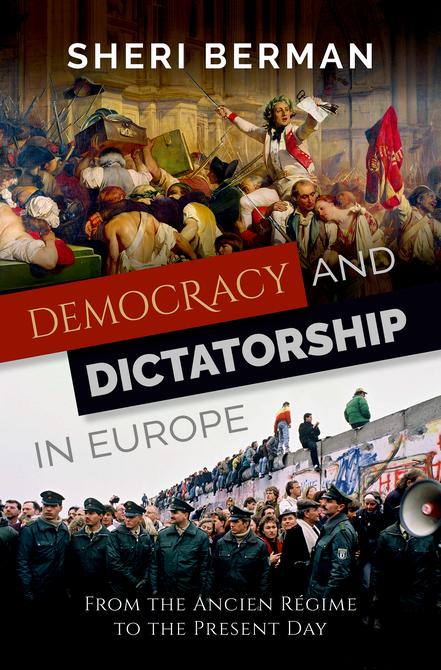Democracy and Dictatorship in Europe
From the Ancien Régime to the Present Day
Oxford University Press is a department of the University of Oxford. It furthers the University’s objective of excellence in research, scholarship, and education by publishing worldwide. Oxford is a registered trade mark of Oxford University Press in the UK and certain other countries.
Published in the United States of America by Oxford University Press 198 Madison Avenue, New York, NY 10016, United States of America.
© Oxford University Press 2019
All rights reserved. No part of this publication may be reproduced, stored in a retrieval system, or transmitted, in any form or by any means, without the prior permission in writing of Oxford University Press, or as expressly permitted by law, by license, or under terms agreed with the appropriate reproduction rights organization. Inquiries concerning reproduction outside the scope of the above should be sent to the Rights Department, Oxford University Press, at the address above.
You must not circulate this work in any other form and you must impose this same condition on any acquirer.
Library of Congress Cataloging-in-Publication Data
Names: Berman, Sheri, 1965– author.
Title: Democracy and dictatorship in Europe : from the Ancien régime to the present day / Sheri Berman.
Description: New York, NY : Oxford University Press, [2018] Identifiers: LCCN 2018027023 (print) | LCCN 2018044301 (ebook) | ISBN 9780199373208 (updf) | ISBN 9780199373215 (epub) | ISBN 9780199373192 (hardcover)
Subjects: LCSH: Europe—Politics and government. | Democracy—Europe—History. | Dictatorship—Europe—History.
Classification: LCC JN8 (ebook) | LCC JN8.B47 2018 (print) | DDC 320.94—dc23
LC record available at https://lccn.loc.gov/2018027023
9 8 7 6 5 4 3 2 1
Printed by Sheridan Books, Inc., United States of America
To those who have struggled to get rid of the ancien régime.
ACKNOWLEDGMENTS
This book has been long—too long—in the making. Indeed at many points I was not sure it would get done. The only advantage of having taken so long is that I have read and learned more about European political history and political development than I ever thought possible. During the many years I worked on this book I tried out parts of the argument on many audiences. To those who came to my talks, panels, and seminars, I offer immense thanks— your questions and criticisms pushed me to think harder about what I wanted to say and how to say it better. During the time this book was percolating I have also published versions its arguments in various venues. I would like to thank the Journal of Democracy and Dissent in particular for publishing several of these essays and their editors for proving feedback on them. My greatest intellectual debt, however, goes to the many Barnard and Columbia students who have taken my “Democracy and Dictatorship in Europe” class over the last decade. This book grew out of this class; after teaching it for several years I realized there was no single book that covered what the course was trying to achieve and that maybe I could be the one to write that book. And each year I taught the course I re-worked the lectures to better communicate important arguments and themes to my students and these lectures provide the intellectual infrastructure for the book that follows. Without this process of constant revision and re-thinking I would never have been able to put the many pieces of the puzzle that is European political development together, so again thank you to the students who pushed me to keep revising and improving. I would also like to thank the many teaching assistants who helped me teach this class and the research assistants who helped me put
together the figures in the book that follows. And finally, I am grateful to Oxford University Press and David McBride for publishing this book and being patient while I struggled to finish it off.
Although they did not directly help with the book, I would like to thank Isaac and Lucy for pushing me and making me determined to show that if you work hard and do not give up you can accomplish what you set out to do. I would also like to thank my wonderful fuzzies for comforting me when I wanted to throw another book I realized I needed to read against the wall or chuck another chapter revision in the trash bin. And finally thanks to the friends who helped me get through my own process of overcoming the ancien régime. Just as this book shows that liberal democracy cannot be consolidated without undergoing this long and painful process, so too did this book’s completion require it.
x acknowledgments
Democracy and Dictatorship in Europe
Questions about Political Development
You have to know the past to understand the present.
InCarl Sagan1
november 1989 the place to be was Berlin. History was being made. Dictatorships were collapsing and, as George H.W. Bush put it, “America [had] won the Cold War.”2 The bloody twentieth century with its horrible violence and titanic ideological battles was coming to a close. Liberal democracy was triumphant, and the West was about to lead the way towards progress and prosperity. Many felt in 1989 as Wordsworth did about the French Revolution exactly two hundred years before: “Bliss was it in that dawn to be alive, / But to be young was just heaven.”3
Europe, of course, was particularly euphoric. The downfall of communism in Eastern Europe combined with the collapse of dictatorships in Southern Europe during the previous decade left the continent more united than ever before. For the first time in its modern history European countries shared the same political (democratic) and economic (capitalist) system; Germany and Russia—the great powers that had caused so much instability in the past—were no longer threats; and the European Union was on the verge of incorporating much of Eastern Europe and creating a single currency. At the end of the twentieth century, the view that a united Europe was on its way to becoming “the next global superpower,” and the model for a new type of peaceful, prosperous, post-national polity, was widespread.4
How fickle is History. Today the optimism of 1989 is long gone, replaced by fears that Europe and the West have entered a period of decline. Liberal democracy has faltered in Eastern Europe and is threatened by populism in Western Europe and the United States. Scholars and commentators no longer talk about the triumph of liberal democracy, the “end of history,” and “postnational” politics, but worry instead about “illiberal democracy,” “global authoritarianism,” virulent nationalism, and democratic “deconsolidation.”5
As Viktor Orbán, Hungary’s current prime minister, whose political career began in 1989 as an opponent of dictatorship but who has since morphed into an opponent of democracy, recently proclaimed: “The era of liberal democracy is over.”6
How did we get from there to here? How can we understand the fate of today’s new democracies and the problems facing its older ones? What makes liberal democracy work well in some places and some times, but not others?
These are questions of the utmost theoretical and practical importance. The rapid spread of democracy at the end of the twentieth and beginning of the twenty-first century combined with its current problems has placed questions concerning the origins, evolution, and fate of democracy at the forefront of contemporary debate. This book will add a fresh perspective to this debate. From historians we have gotten superb studies of particular countries’ politics at particular points in time. From political scientists we have gotten theories about what it takes to make democracy work.7 And more recently, scholars and commentators have provided analyses of democracy’s current crisis.8 This book draws on and aims to complement the work of historians, political scientists, and contemporary analysts of democracy. It is grounded in the view, as Carl Sagan put it, that one “has to know the past to understand the present.” It will integrate questions being asked about democracy today with a re-consideration of European political development in order to gain a better understanding of how and why democracies and dictatorships developed in the past. And by reconsidering how democracies and dictatorships developed in the past it will add a historical perspective that will enable us to better understand what is going on in the world today.
Europe is the perfect place to ground such an examination: it is the place where modern democracy was born and is currently the home of a large crop of well- and not-so-well-functioning democracies. In addition, Europe has also been the home of dictatorships of all kinds—monarchical, military, populist, hybrid, competitive, fascist, and National Socialist. These democracies and dictatorships emerged, moreover, at various times and in various economic and social contexts. Indeed over the course of the modern era, European countries have differed in almost every way political scientists identify as
causally significant for democratic development: timing, nature, and rapidity of economic development; levels of economic inequality; strength of national states; degree of ethnic and religious diversity; and more. That so many types of political regimes and such immense economic and social diversity have existed in Europe provides an opportunity to study how democracies and dictatorships develop and decay over time and in various contexts.
In addition to placing the European experience in broader context and bringing a historical perspective to the consideration of contemporary cases, a re-examination of political development in Europe can help us understand the problems its own democracies face today. After a half century of unprecedented political, social, and economic success, Europe is once again experiencing profound political malaise and even political disorder. Most commentary on Europe’s present problems has focused on contemporary causes like globalization, technological change, the financial crisis, technocracy, immigration, and refugee flows. This book will show, however, that short-term analyses misunderstand or at least oversimplify what is going on. In particular, the historical perspective adopted in this book will help us see how Europe’s current problems have their roots in the decay of the foundations upon which liberal democracy was (re)built after the tragedies of the interwar period and the Second World War.
Before moving on, it is necessary to briefly define some key concepts used throughout the book: democracy, democratization, and consolidation. The first seems straightforward, but in fact students of democracy have almost as many definitions of it as there are regimes in existence.9 The latter two, meanwhile, although conceptually and practically related, represent different stages or parts of the political development process; too often contemporary commentary conflates or fails to clearly differentiate them, leading to confusing analyses, assertions, and policy recommendations. Some conceptual brush-clearing, in short, is necessary before the analysis begins.
Key Concepts
The term “democracy” derives originally from the Greek word for popular rule, demokratia (demos = “common people,” and kratos = “rule” or “power”).10 Although defining democracy as “rule by the people” seems uncomplicated, it is actually too ambiguous to be used to analyze or compare political systems. For example, who are “the people”? Does rule by “the people” mean all “the people” or just some subgroup of them? And how about “rule”? Do “the people,” however defined, have to rule directly in order for a system to be
considered democratic or should indirect, mediated, or technocratic rule also be considered democratic? Must “the people” agree on all political decisions or at least share a conception of the “common good” in order for a political system to be considered democratic or can there be conflicts among “the people” on what “rule” should entail in a democratic system?
Because of questions like these, social scientists have tried to come up with definitions of democracy better suited to empirically analyzing and comparing political regimes. Perhaps the one most oft used by scholars and policy makers today is a “minimal” or “electoral” definition which characterizes political regimes based on their procedures, particularly those used to pick rulers. In this view, the central procedure of democracy—and the feature that distinguishes it most clearly from other types of political regimes—is the selection of leaders through competitive elections by the people they govern. The most important modern statement of this definition of democracy was given by Joseph Schumpeter in his classic Capitalism, Socialism and Democracy. According to Schumpeter, “the democratic method is that institutional arrangement for arriving at political decisions in which individuals acquire the power to decide by means of a competitive struggle for the people’s vote.”11 For Schumpeter, in other words, the need for leaders to compete for support or win elections rather than coming to power via coercion or heredity is the most important distinction between democracy and dictatorship. It is important to note that while its focus on elections is fairly simple and straightforward, this definition of democracy also implicitly includes a number of civil and political rights, such as some degree of freedom of speech, assembly, and organization since without them, elections could not be considered truly competitive, or “free and fair.”
This “minimal” or “electoral” definition of democracy has many advantages. First, it is intuitive; most people recognize free and fair elections as the central feature of democracy. Second, it provides concrete, empirical benchmarks that can be used to differentiate democracy from dictatorship: if a country denies the right to participate in free and fair elections to its citizenry, then it is not democratic. Third, in addition to enabling us to judge the nature of any particular political system at any particular point in time, this definition also helps us analyze whether it is moving in a democratic or non-democratic direction: as elections become “freer and fairer” and/or increasing numbers of citizens are able to participate in them, countries can be characterized as becoming more democratic, or democratizing.
The “minimal” or “electoral” definition of democracy thus allows for relatively clear-cut and straightforward comparisons of political regimes. Some scholars, however, think the benefits of this definition’s parsimony are
outweighed by costs in terms of accuracy. In particular, critics assert that proponents of this definition are guilty of the “fallacy of electoralism”—of assuming that relatively free and fair elections indicate a well-functioning democracy. Surely anyone who reads a newspaper today can come up with examples of relatively free and fair elections gone awry. For example, many currently worry about the growing popularity of populist parties and politicians in the West whose commitments to liberalism and perhaps even democracy are uncertain. Similar concerns were voiced during the Arab Spring when many worried that elections would bring to power Islamists whose commitments to democracy were weak or instrumental. Indeed, such concerns were invoked in Egypt to help justify the overthrow of the Muslim Brotherhood’s Mohamed Morsi and when the Algerian government voided the results of a democratic election that was about to be won by the radical Islamic Salvation Front (FIS) in 1992. Commenting on the United States’ support of the Algerian government in this latter case, then Assistant Secretary of State Edward Djerejian explained that the United States favored democratization but did not support groups that believed in “one person, one vote, one time.”12 Such concerns, of course, are nothing new. Infamously, both Hitler and Mussolini pursued an “electoral path” to dictatorship; this book will discuss many other cases from European history where elections brought to power politicians and parties with at best tenuous commitments to democracy.
In addition to worrying about elections leading to governments that subsequently undermine democracy, critics also worry about democratically elected governments using their power in “non-democratic” or illiberal ways. Once again anyone who pays attention to current events could come up with numerous contemporary examples of such behavior. For example, Orbán in Hungary, the Law and Justice party in Poland (led by Jarosław Kaczyński), and Recep Tayyip Erdoğan in Turkey all came to power via relatively free and fair elections and then used their power to reward supporters and punish detractors, and more generally undermine democratic procedures and institutions. And also in the still fairly recent European past, democratically elected leaders in the former Yugoslavia sanctioned or incited violence against minorities in their own countries. As Richard Holbrooke famously asked before the 1996 elections in Bosnia, “Suppose elections are free and fair and those elected are racists, Fascists, separatists? That is the dilemma.”13
Because it is not hard to find cases of democratic elections gone awry, and because many believe that while necessary, free and fair elections are not sufficient to make a political system fully democratic, many scholars argue for going beyond a minimal or electoral definition of democracy and favor
a “liberal” one instead. As the term “liberal” indicates, proponents of this view argue that democracy is not merely a political system that chooses its leaders in a particular way; it is also a political system where government and citizens act in particular ways, namely in accordance with the tenets of liberalism. As the American Declaration of Independence declared: “We hold these truths to be self-evident, that all men are created equal, that they are endowed by their Creator with certain unalienable Rights, that among these are Life, Liberty and the pursuit of Happiness.” In this view, in order to be considered truly or fully democratic, a government must be willing and able to guarantee the rule of law; and must protect minorities and individual liberties; and leaders and citizens must respect the democratic “rules of the game,” and treat all members of society as political equals. The “liberal” definition of democracy is thus deeper than the electoral or minimal one. It incorporates into our understanding of democracy a set of values or goals that cannot be secured by political procedures alone. Democracies differ from dictatorships, in other words, not only in the way in which they choose their leaders, but also in the way they treat their citizens and their citizens treat each other.
The liberal definition of democracy has real advantages. First, it avoids the “fallacy of electoralism”: it does not assume that particular procedures, most importantly relatively free and fair elections, are all it takes to make democracy. Second, it explicitly incorporates a wide variety of liberal rights that many view as inherently part of any truly democratic system. Third, it allows us to engage in more fine-grained and multifaceted, if somewhat fuzzier and more complicated,14 comparisons of political regimes than does the minimal or electoral definition of democracy. Indeed, the more stringent requirements of liberal democracy clearly eliminate countries like Hungary, Poland, and Turkey and many others from the democratic category.15 Precisely to capture the fact that many democracies are not liberal, another political label— illiberal democracy—is often invoked. Like electoral democracies, illiberal democracies have relatively free and fair elections but few if any of the other trappings of liberal democracies: they do not fully or indiscriminately apply the rule of law, protect minorities, or ensure individual liberties.
European history offers the perfect context within which to examine the nature, dynamics, and implications of different types of democracy. The following chapters investigate how common these different types of democracy have been; the factors determining whether a country develops an electoral, illiberal, or liberal democracy; and whether and how the development of illiberal democracy affects the development of liberal democracy down the road.16 Some scholars, for example, assert that countries that democratize
before the conditions to sustain liberal democracy are in place are likely to become “stuck” in illiberalism. As one influential treatment of the topic puts it, “Premature, out-of-sequence attempts to democratize may make subsequent efforts to democratize more difficult and more violent than they would otherwise be.”17 Is this true? Has electoral or illiberal democracy precluded progress towards liberal democracy in the past? Are electoral or illiberal and liberal democracy “competing” regime types or rather different stages of political development?
Alongside investigating the nature, dynamics, and implications of different types of democracy, two other key foci of Democracy and Dictatorship in Europe are democratization and consolidation.
Democratization refers to the transition from dictatorship to democracy. It is a process, not a stable condition. Democratization implies nothing about the durability or health of democracy. Democratization may occur and the new democracy may be weak or short-lived. Once again, European history provides a great context for investigating how and why democratization occurs and how often it leads to stable democracy. The following chapters examine many cases of democratization in Europe from the seventeenth century on in order to shed light on how and why dictatorial regimes are replaced by democratic ones and to determine how common it has been for democratization to lead to consolidation rather than instability or democratic failure.
Consolidation is what potentially happens after democratization: it is when the collapse of a dictatorship leads to the formation of a successful democracy. But how should democratic success be measured? Some scholars and observers focus on durability. In this view, democracy should be considered consolidated if it lasts for some significant period of time. But what should that period be? Five years? Ten years? A generation? Because any particular time period might seem arbitrary, some prefer a measure of durability that defines a democratic regime as consolidated when it has successfully carried out a certain number of elections.18
If one rejects, however, an electoral or minimal definition of democracy, then a purely quantitative definition of consolidation focused on durability or elections will be insufficient. Many scholars and observers accordingly favor a qualitative definition of consolidation that focuses on the attitudinal and behavioral shifts that comport with liberal democracy. In this view, a consolidated democracy requires that all groups are allowed to participate in political life and voice their demands, as long as they do so within the “rules of the game”; the basic rights of minorities and individuals are respected by the government as well as other citizens; and support for democracy is
principled rather than conditional—that is, leaders and citizens view it as the only legitimate political system, not merely suitable because it produces particular policies or electoral outcomes, but rather because it comports with a society’s deeply held values and preferences.19 The following chapters will investigate how and under what conditions democratic consolidation has occurred in the past. As we will see, consolidated liberal democracy is a rare and recent phenomenon, with a much more difficult and turbulent backstory than most contemporary observers recognize. This brings us to some of the book’s major themes and arguments.
Key Themes and Arguments
Based on the belief that we need to know the past to understand the present, Democracy and Dictatorship in Europe takes questions people are asking about democratic development and decay today and places them into historical perspective. One obvious advantage of a historical perspective is that without it we cannot know whether the problems facing democracy today are distinctive to the contemporary period or fairly common characteristics of political development. Indeed one argument this book will make is that much commentary on the state of democracy today is implicitly based on mistaken assumptions about how political development unfolded in the past. Another advantage of a historical perspective is that it enables us to recognize and understand the long-term causes and consequences of critical political events. This book will argue that political development is best understood as a marathon and not a sprint: it can take a long time for certain transformations to work themselves out and for the implications of distinct decisions or dynamics to become clear. Any attempt to understand the fate of a particular democratic experiment must take into account not only conditions surrounding the transition, but also the deep historical legacies from previous regimes that each attempt must wrestle with. Understanding how this process unfolded in Europe in the past can help us understand it in other parts of the world and during other periods.
This book’s analysis begins in the seventeenth century, during the period of the ancien régime, when modern states began to emerge in Europe. As we will see, the nature of Europe’s old regimes, and in particular whether and how they engaged in state-building, dramatically affected subsequent political development. Few political scientists delve this deeply into history, and this has produced a distorted picture of Europe’s modern political development. The old regime was more than a type of dictatorship; it was a
social and economic system as well. Eliminating it would therefore require more than a change in political institutions; revolutionary transformations in society and economy would also be necessary. Beginning with the French Revolution, many political transitions took place across Europe but, as we will see, almost all these democratic experiments failed because more representative political systems were grafted onto societies and economies in which the institutions, relationships, and norms of the old regime remained. Moreover, while dissatisfaction with the old regime in general and dictatorship in particular became increasingly widespread during the nineteenth and early twentieth centuries, a consensus on what should replace it did not emerge until the second half of the twentieth century, at least in some parts of Europe. Indeed, Democracy and Dictatorship in Europe will show that the best way to understand modern European political history is as a struggle to eliminate the vestiges of the old regime and build a consensus about the type of regime that should replace it. This process began in 1789 in France (even earlier in Britain) and then spread across the continent, reaching its climax during the interwar period and only being settled after 1945 in Western Europe, during the latter part of twentieth century in Southern Europe, and the process continues in Eastern Europe in today. We will see, in short, that getting rid of an old regime is a necessary but not sufficient condition for constructing a liberal democratic one. European history offers us many examples of times when an old order has died or is decaying but a new one has not yet arisen. Such periods are interregnums, and precisely because they are dominated by conflicts over what a new order should look like, they tend to be disordered and even violent. We may, in fact, be living through one today, so understanding how they have played out in the past is crucial.
In addition, beginning the analysis in the seventeenth century will make clear that in politics as in economics there is no “free lunch,” that is, the idea that a gradual, liberal, non-violent path to democracy exists is based on a misreading or misinterpretation of history. Although such a path is certainly attractive in theory, there are in fact very few cases of stable liberal democracies that developed in this manner. Indeed, we will see that the political backstory of most democracies is one of struggle, conflict, and backsliding. More optimistically, we will also see that problems and even failures do not preclude later democratic success. Indeed, in Europe problems and failures turned out to be integral parts of the long-term processes through which non-democratic institutions, elites, and cultures were delegitimized and eventually eliminated, and their democratic successors forged. Many contemporary analysts do not seem to realize this because of a lack of historical perspective: they often ignore or misread the frequently messy and
unattractive manner in which the current crop of liberal democracies actually developed and their analyses of democracy today are accordingly faulty.
This book will also focus on the connections between state- and nationbuilding and the development of democracy. There is much discussion today of the importance of strong states and national unity for well-functioning liberal democracy. Again, Europe provides a great context within which to study this, since the development of and relationship among states, nations, and democracy varied greatly in its past. In Western Europe fairly strong states and nations emerged before capitalism began reshaping societies or the challenge of democratization appeared on the political agenda. In other parts of Europe, the sequence differed. In Spain state- and nation-building began in the early modern period, but stalled and so the challenges of economic development and democratization had to be faced with a weak state and weak national identity. In Italy a national state emerged only in the late nineteenth century and then had to quickly confront the challenges of nation-building, economic development, and democratization. And in Eastern Europe independent countries only emerged after World War I, and, as in other newly decolonized regions, the challenges of state-, nation-, and democracy-building had to be confronted simultaneously. As we will see, how countries dealt with the legacies of their old regimes and how easy it was to build a consensus around a new one was profoundly influenced by the sequencing of state-, nation-, and democracy-building.
A final theme of Democracy and Dictatorship in Europe is the distinctiveness and import of the new order constructed by the United States and Western Europe after 1945. Although many forget it now, this postwar order was the foundation upon which consolidated liberal democracy was finally built in Western Europe. It was only after the chaos and devastation of the interwar years and the Second World War that a consensus emerged on the desirability of liberal democracy as well as on what it would take to make it work. This consensus undergirded the construction of international, regional, and domestic structures and relationships that finally generated peace, prosperity, and political stability in Western Europe. Understanding the postwar order, in short, is necessary to understand why democracy consolidated in Europe after 1945 but not before. And this order’s decline over the past decades helps explain the problems liberal democracy is facing in Europe today.
In short, Democracy and Dictatorship in Europe will take the reader through a tour of the European past not in order to re-tread well-worn historical territory, but rather to provide an integrated and coherent story of European political development, making clear how episodes from the French Revolution to the collapse of the Weimar Republic to the building of the postwar order in Western Europe to the construction and destruction of communism in
Eastern Europe relate to each other and the larger story of the development of liberal democracy.
Book Outline
Democracy and Dictatorship in Europe will examine the development of democracies and dictatorships in Europe from the ancien régime up through the present day. It does not cover every European country in depth but instead focuses on countries that enable variations on certain critical factors that influence political development—including the nature and sequencing of state-, nation-, and democracy-building; the timing, type, and rapidity of economic development; and the degree of ethnic, religious, and linguistic diversity—to be considered. France, Italy, Germany, Britain, Spain, and East-Central Europe are covered extensively; other European countries are considered briefly, and Russia only enters the analysis when its own political development directly affected that of other European countries, for example, after the First and Second World Wars.
Chapter two focuses on the early modern period. It examines the type of political regime that dominated Europe during this time—monarchical and particularly absolutist dictatorships—as well as the era’s most important feature—the emergence of modern states. The focus is on understanding the main features of the French ancien régime, with comparisons to developments in other parts of Europe. The chapter analyzes the type of state-building that occurred in France and other parts of Europe and highlights some of the ways this process influenced subsequent political development.
Chapter three examines early modern Britain and in particular the civil wars, regime changes, and Glorious Revolution of the seventeenth century. It analyzes how Britain’s conflictual seventeenth century reflected previous state- and nation-building efforts and how seventeenth-century conflicts laid the foundation for the unusually peaceful and gradual political trajectory Britain would follow from the eighteenth century on.
Chapter four examines the French Revolution, taking up the story where chapter two left off. It analyzes why the French monarchy became vulnerable to collapse by the end of the eighteenth century and why, when it did collapse, a revolution, rather than a less tumultuous transition occurred. It also examines why the first modern democratic experiment produced by the revolution20 led to state terror and a populist military dictatorship rather than consolidated liberal democracy. And it begins considering how
questions about political development 11
the revolution would influence subsequent French and European political development.
Chapter five examines 1848, the next major turning point in Europe’s political development. During this year a democratic wave swept across much of Europe, quickly toppling monarchical dictatorships. Yet barely two years later, this democratic wave had receded and Europe was back under dictatorial rule. The chapter explains why this democratic wave succeeded and then failed so spectacularly, focusing on the role played by class and communal conflicts in determining political outcomes.
The next three chapters examine European political development during the late nineteenth and early twentieth centuries, focusing on the development and growing conflict between nationalism and democracy. Chapter six examines the French Third Republic. It analyzes the transition to and the nature of the Third Republic. This Third Republic turned into France’s longest-lived regime since the revolution and achieved important successes but was also marred by critical weaknesses. The chapter investigates the Third Republic’s weaknesses through the prism of the Dreyfus Affair, the most important crisis the Republic confronted before the First World War.
Chapters seven and eight examine the unifications of Italy and Germany, respectively. These chapters analyze the states produced by these unification processes and how they influenced subsequent German and Italian political development, particularly via their impact on nation-building and by shaping the way the struggle for democratization would play out during the late nineteenth and early twentieth centuries.
The next five chapters focus on European political development during the interwar period. Another democratic wave swept Europe after the First World War, toppling dictatorships across the continent. However, by the end of the interwar period many of these new democracies had collapsed, some into a new and virulent type of dictatorship—fascist or National Socialist. Chapter nine examines the struggle for democracy in interwar France. It considers the main challenges confronting the Third Republic after the First World War and investigates why French democracy was able to survive until 1940, but in a weakened and troubled state.
Chapter ten examines British political development during the nineteenth and early twentieth centuries. It analyzes why Britain remained fairly stable during the nineteenth century when the rest of Europe was characterized by turmoil and upheaval as well as why it proved relatively immune to the extremism and democratic decay plaguing much of the rest of Europe during the interwar years.
Chapter eleven returns to Italy, asking why Italian democracy collapsed so quickly after the First World War. It investigates the causes of the political instability and violence Italy experienced after 1918 and the reasons why Mussolini and the fascists were able to take advantage of democracy’s problems. The chapter also examines the nature and consequences of the fascist dictatorship in Italy.
Chapter twelve examines the interwar Weimar Republic. It investigates the causes of the Republic’s collapse and the reasons why Hitler and the Nazis were the eventual beneficiaries of it. The chapter also analyzes the nature and consequences of the Nazi dictatorship.
Chapter thirteen examines Spanish political development. It begins with a consideration of state- and nation-building during the early modern period and analyzes how these influenced Spain’s subsequent political development. The chapter focuses on the instability and violence plaguing Spain during the nineteenth and early twentieth centuries and asks why traditional conservative forces were able to retain immense power in Spain, while their influence was waning in much of the rest of Europe. The chapter also analyzes why Spain’s interwar democratic experiment failed and why this failure led to civil war and a relatively traditional conservative dictatorship rather than fascism.
The next four chapters of Democracy and Dictatorship in Europe examine the second half of the twentieth century. Chapter fourteen examines postwar Western Europe, examining why liberal democracy was able to consolidate after 1945, having failed so often in the past. It focuses on how the Second World War and the changes that occurred after it at the international, regional, and domestic levels enabled Western Europe to put the instability, conflict, and violence of the previous 150 years behind it.
Chapter fifteen examines the transition to communism in East-Central Europe after 1945. Like Western Europe, East-Central Europe’s postwar political development diverged greatly from the prewar period. But while this divergence landed Western Europe finally in the liberal democratic camp, East-Central Europe ended up ruled by communist dictatorships. The chapter investigates the domestic and international reasons for this political outcome and the main features and consequences of communist dictatorships in East-Central Europe.
Chapter sixteen investigates the background, timing, type, and consequences of Spain’s transition to democracy in the 1970s. It examines the Francoist dictatorship that ruled Spain after the civil war and how it transformed Spain’s economy and society, the nature of the transition to
democracy, and the reasons why democratic consolidation occurred relatively quickly and easily in Spain during the late twentieth century.
Chapter seventeen examines the transition to democracy in East-Central Europe. It asks why attempts at political liberalization failed in East-Central Europe in the 1950s, ’60s, and ’70s, but democratization succeeded in 1989. It also investigates why, when democratization occurred, it was peaceful and negotiated in some East-Central European countries but accompanied by mass protests and elite intransigence in others. And finally, it considers how legacies of communism continue to influence the region’s political development today.
Chapter eighteen, the conclusion, summarizes the book’s findings and discusses the implications of the European experience for contemporary debates about democratization and consolidation. In particular, it lays out several crucial lessons European history provides about the development of democracy and dictatorship and reiterates the contributions a historical perspective on political development can provide to those struggling to understand the challenges facing democracy in Europe and many other parts of the world today.



